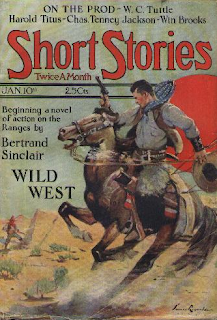
Purchased just last week, a century or so after it arrived at the news agent, the December 1911 edition of
The Canadian Magazine was hard to resist. Just look at what's on offer: "A Study of Iago" by
Arthur Stringer, some thoughts on winter by L.M. Montgomery, a new Homer Watson and no less than ninety lines of verse from the delightfully quirky
Isabel Ecclestone Mackay.
But what really sold me was "The Mad Player", an uncollected work by Frank L. Packard. Something just less than 4000 words in length, this simple story is reflected in the accompanying illustrations by J.W. Beatty, R.C.A., O.S.A.
The unnamed narrator is a landscape artist travelling somewhere in France. One evening he comes upon a wild looking violinist busking on a village street.
The painter returns to lodgings, where he is confronted by the violinist – as a fellow artiste, he is offended that our narrator put a coin in his cap. Things are becoming quite unpleasant until the eyes of the unkempt musician fall upon the painter's most recent landscape:
"Monsieur will tell me where it was done – where?"
When told, he rushes out. The innkeeper, who is highly amused, fills in our narrator. It seems that the wild violinist is an aristocrat who as a young man lost his mind at the drowning death of his fiancée.

The following morning, the violinist's body is discovered near the spot captured in the landscape. Wracked with guilt, the painter watches the cortege. He returns to the landscape, trying to make sense of the insane aristocrat's reaction. Though it takes some time, he realizes that the violinist viewed the work upside down.
I reversed it quickly – and then I, as he had done, with startled cry, carried it closer to my eyes. At last I understood. The foliage, by some grim freak as my brush had traced it, bore a crude, but unmistakable resemblance to a woman's face, with her hair streaming down touching the river's brink – and to the poor, crazed brain it had been the end of a long search!
FIN
"The Mad Player" is the work of a man honing his craft as a storyteller; it's well-written, intriguing and, ultimately, most unsatisfying.
When the story appeared in The Canadian Magazine, Packard was labouring as a civil engineer; fortune and fame were still in the future. That said, 1911 did see the publication of On the Iron at Big Cloud, his very first book.

Though Thomas Y. Crowell, Packard's publisher, didn't advertise in this magazine, a whole lot of houses did. Macmillan, Cassell & Co., William Briggs, Oxford University Press, the Upper Canada Tract Society and Copp, Clark all took out full page adverts, only to be overwhelmed by a pink, four-page spread for the brand new Eleventh Edition of the Encyclopædia Britannica.
I ask, who wouldn't want to be met like this on Christmas morn?



































